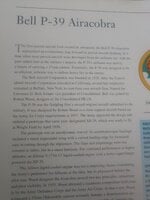Shortround6
Lieutenant General
Which P-40s were designed as fighter bombers?P40 's were actually designed as a fighter bomber, hence the low end super charging.
This is among the Great Myths of WW II Aviation. The P-40 (no letter) was designed to be the best high altitude fighter the US Army could get in numbers in 1940. Not 1941 or in 1942.
The Army knew the Turbo charged P-38 and P-35 offshoot that became the P-43 were not going to be ready for squadron service in 1940. Allison could offer an engine that gave 1040hp at 14,300ft which was better than anything anywhere except the Merlin III (this was the Spring of 1939)
Now things get a little confusing because the Army doesn't get what they ordered right away. The $12,872,398.00 order to Curtiss on April 27th 1939 for 560 aircraft (524 complete aircraft and 36 as spare parts) takes a while to get going and Allison has to tool up to make the engines. The first Production P-40 wasn't flown until April 4th 1940 and it wasn't accepted by the Army for 3 weeks.
The confusion really sets in with the Army agreeing to defer deliveries so the French and British can get aircraft that they had ordered in 1939/early 1940. The Army doesn't get the 524 aircraft they ordered. They get 200(?) and take deliveries of of the rest as P-40Bs and P-40Cs.
To keep things short, the P-40 no letter and the P-40B did not have a belly rack for either fuel tank or bomb. That doesn't show up until the P-40C. The Early British (ex French) Tomahawks did not have the belly rack either. There are some sources that claim that the early versions could have under wing racks for small bombs.
Now the early versions with the under fuselage tank were not intended for bombing. It was found (by several people?) that they could sling a 500lb under the fuselage using the drop tank fittings.
In Fact the manual for the P-40D & E published April 25th 1941 and revised Sept 5th 1941 makes no mention of using a bomb underneath the fuselage. They do say that 3 20lb bombs can be carried underneath each wing with either M42 fragmentation bombs or type T7 practice bombs. Manual lists both manual release type and electrical release type (trigger).
As we all know the P-40D&E did carry bombs under the fuselage in service. But the fact that the P-40 was designed as a fighter bomber is a myth. It was adopted into one.
The type of engine used was what they could get their hands on, not a choice because they only intended the plane to be flown at low altitude.

